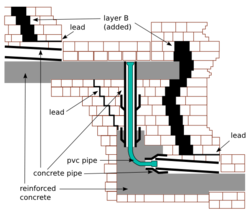
A Buddha statue with the hand position of dharmachakra mudra (turning the Wheels of the Law)
The Buddha statues are in niches at the Rupadhatu level, arranged in rows on the outer sides of the balustrades, the number of statues decreasing as platforms progressively diminish to the upper level. The first balustrades have 104 niches, the second 104, the third 88, the fourth 72 and the fifth 64. In total, there are 432 Buddha statues at the Rupadhatu level. At the Arupadhatu level (or the three circular platforms), Buddha statues are placed inside perforated stupas. The first circular platform has 32 stupas, the second 24 and the third 16, that add up to 72 stupas. Of the original 504 Buddha statues, over 300 are damaged (mostly headless) and 43 are missing (since the monument's discovery, heads have been stolen as collector's items, mostly by Western museums).
At glance, all the Buddha statues appear similar, but there is a subtle difference between them in the mudras or the position of the hands. There are five groups of mudra: North, East, South, West and Zenith, which represent the five cardinal compass points according to Mahayana. The first four balustrades have the first four mudras: North, East, South and West, of which the Buddha statues that face one compass direction have the corresponding mudra. Buddha statues at the fifth balustrades and inside the 72 stupas on the top platform have the same mudra: Zenith. Each mudra represents one of the Five Dhyani Buddhas; each has its own symbolism.
Following the order of Pradakshina (circumumbulation) clockwise movement start from the east, the mudras of Borobudur buddha statues are:
Statue | Mudra | Symbolize | Dhyani Buddha | Cardinal Point | Location of the Statue |
|---|---|---|---|---|---|
 | Bhumisparsa mudra | Call for the earth as the witness | Aksobhya | East | Rupadhatu niches on first 4 eastern balustrades |
 | Vara mudra | Benevolence, alms giving | Ratnasambhava | South | Rupadhatu niches on first 4 southern balustrades |
 | Dhyana mudra | Concentration and meditation | Amitabha | West | Rupadhatu niches on first 4 western balustrades |
 | Abhaya mudra | Courage, without fear | Amoghasiddhi | North | Rupadhatu niches on first 4 northern balustrades |
 | Vitarka mudra | Reasoning and virtue | Vairochana | Zenith | Rupadhatu niches in all directions on 5th (uppermost) balustrades |
 | Dharmachakra mudra | Turning the wheel of dharma (law) | Vairochana | Zenith | Arupadhatu in 72 perforated stupas on 3 rounded platform |
Restoration
Borobudur attracted attention in 1885, when Yzerman, the Chairman of the Archaeological Society in Yogyakarta, made a discovery about the hidden foot. Photographs that reveal reliefs on the hidden foot were made in 1890–1891. The discovery led the Dutch East Indies government to take steps to safeguard the monument. In 1900, the government set up a commission consisting of three officials to assess the monument: Brandes, an art historian, Theodoor van Erp, a Dutch army engineer officer, and Van de Kamer, a construction engineer from the Department of Public Works.In 1902, the commission submitted a threefold plan of proposal to the government. First, the immediate dangers should be avoided by resetting the corners, removing stones that endangered the adjacent parts, strengthening the first balustrades and restoring several niches, archways, stupas and the main dome. Second, fencing off the courtyards, providing proper maintenance and improving drainage by restoring floors and spouts. Third, all loose stones should be removed, the monument cleared up to the first balustrades, disfigured stones removed and the main dome restored. The total cost was estimated at that time around 48,800 Dutch guilders.
The restoration then was carried out between 1907 and 1911, using the principles of anastylosis and led by Theodor van Erp. The first seven months of his restoration was occupied with excavating the grounds around the monument to find missing Buddha heads and panel stones. Van Erp dismantled and rebuilt the upper three circular platforms and stupas. Along the way, Van Erp discovered more things he could do to improve the monument; he submitted another proposal that was approved with the additional cost of 34,600 guilders. At first glance Borobudur had been restored to its old glory.
Due to the limited budget, the restoration had been primarily focused on cleaning the sculptures, and Van Erp did not solve the drainage problem. Within fifteen years, the gallery walls were sagging and the reliefs showed signs of new cracks and deterioration. Van Erp used concrete from which alkali salts and calcium hydroxide leached and were transported into the rest of the construction. This caused some problems, so that a further thorough renovation was urgently needed.
Small restorations have been performed since then, but not sufficient for complete protection. In the late 1960s, the Indonesian government had requested from the international community a major renovation to protect the monument. In 1973, a master plan to restore Borobudur was created. The Indonesian government and UNESCO then undertook the complete overhaul of the monument in a big restoration project between 1975 and 1982. The foundation was stabilized and all 1,460 panels were cleaned. The restoration involved the dismantling of the five square platforms and improved the drainage by embedding water channels into the monument. Both impermeable and filter layers were added. This colossal project involved around 600 people to restore the monument and cost a total of US$ 6,901,243. After the renovation was finished, UNESCO listed Borobudur as a World Heritage Site in 1991. It is listed under Cultural criteria (i) "to represent a masterpiece of human creative genius", (ii) "to exhibit an important interchange of human values, over a span of time or within a cultural area of the world, on developments in architecture or technology, monumental arts, town-planning or landscape design", and (vi) "to be directly or tangibly associated with events or living traditions, with ideas, or with beliefs, with artistic and literary works of outstanding universal significance".



0 comments:
Post a Comment